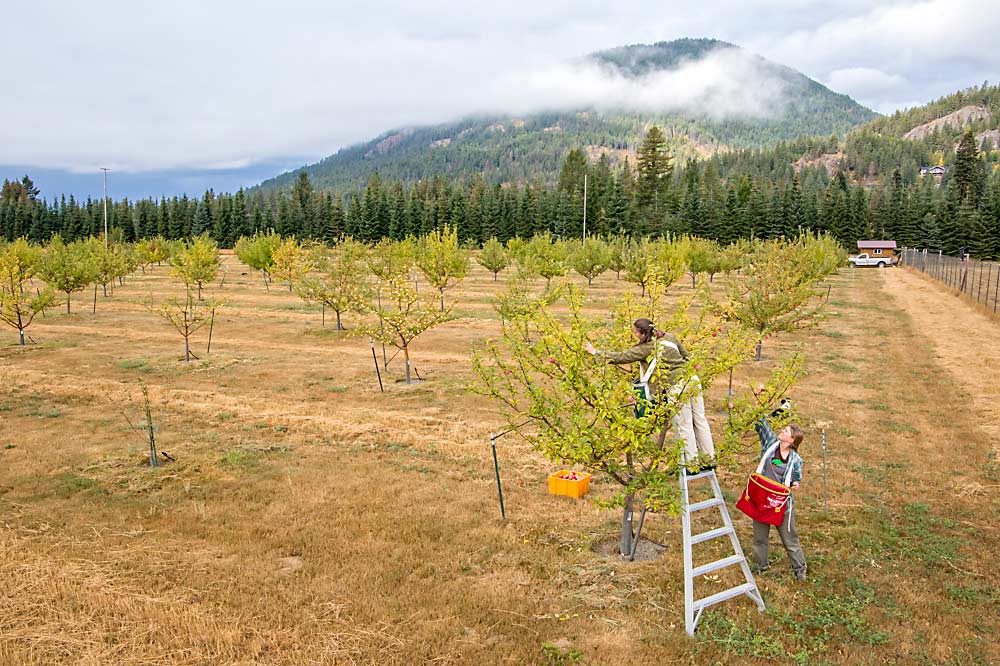
Jana Hershberger, on ladder, and Josie Greenwood harvest apples in September 2018 at the University of Idaho Sandpoint Organic Agriculture Center. The property, a former commercial farm and wellness center, features the orchard, dorm rooms, a conference facility and a cider house. It was partially donated to the university by a retired clothing company owner in 2018. (Ross Courtney/Good Fruit Grower)
As tendrils of fog lift from the surrounding fir-covered hills, Kyle Nagy visits his trees one by one to check the maturity of his orchard’s 68 apple varieties.
He plucks a Niedzwetzkyana (pronounced need-VETZ-kee-ah-na), one of the Sandpoint, Idaho, orchard’s five red-fleshed varieties. As his knife breaks the skin, a juice so red it could be from a pomegranate oozes over his blade and fingers. It’s beautiful but bitter enough to make anyone pucker.

Center superintendent Kyle Nagy slices open a Niedzwetzkyana, a purple-skinned, red-fleshed apple and one of 68 different varieties in the Sandpoint orchard. (Ross Courtney/Good Fruit Grower)
“When I’m giving tours and there’s a high schooler that won’t stop talking, I give him this apple,” said Nagy, the superintendent and orchard operations manager of the University of Idaho Sandpoint Organic Agriculture Center.
An orchard with heirloom varieties of odd shapes and colors, a working conference center, a cold-storage room and dormitories are among the attractions of the 66-acre center, the bulk of it donated last year to the university’s College of Agricultural and Life Sciences by a retired clothing retail CEO.
The university is trying to turn the facility into a paradigm of sustainable farming education, boosting the visibility of the university and its agricultural programs in the mountainous northern panhandle of the Gem State, known more for vast commercial potato production than tree fruit.
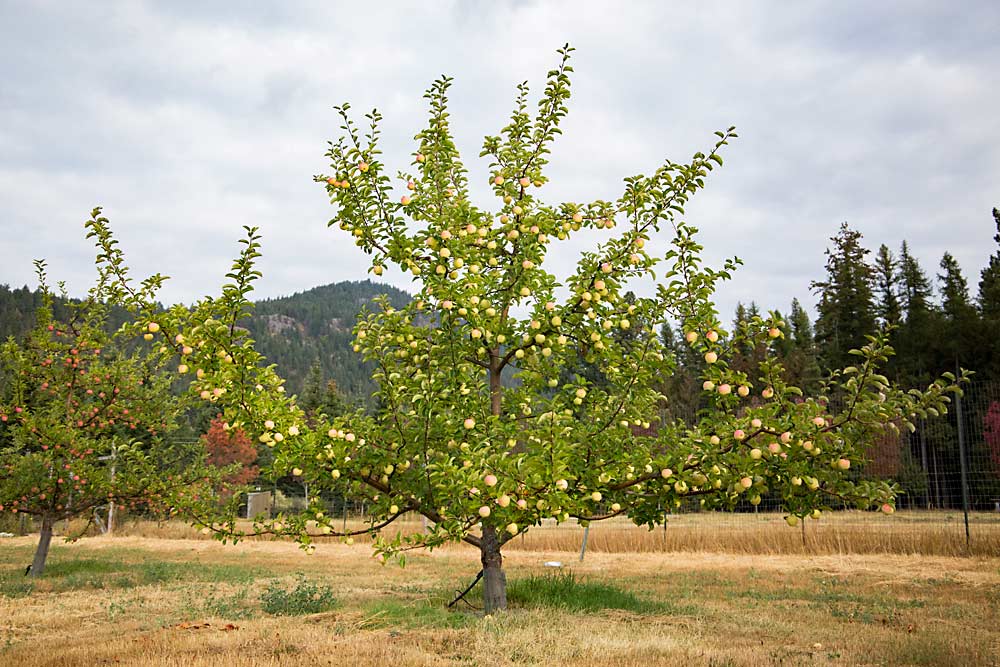
Green Seek-No-Further apples approach maturity in September 2018 at the University of Idaho Sandpoint Organic Agriculture Center. (Ross Courtney/Good Fruit Grower)
“It’s a transformational thing for us as a college,” said Michael Parrella, dean of the College of Agricultural and Life Sciences.
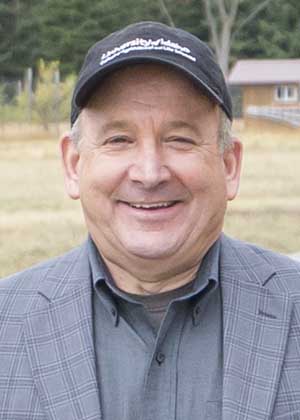
Michael Parrella
Parrella and the ag college plan to make the center an education and outreach facility, to complement the work conducted at the university’s nine other research and extension centers. They plan to move faculty to the center full-time and hire new staff, holding courses in soil sciences and other disciplines.
The facility also has land for vegetables, grains and row crops, as well as barns for animal husbandry and 4-H programs, but the orchard, which includes some sweet cherry cultivars, is the centerpiece. Previously, the university’s fruit presence was limited to the Parma Research and Extension Center in Parma, six hours south, near Boise, home of the university’s pomology and viticulture program.
“Just out of curiosity”
The orchard was started by Dennis Pence, founder and then CEO of the Sandpoint-based Coldwater Creek women’s clothing company. He purchased the property as a buffer against development for his neighboring home — around 2007, about the time of the company’s peak and his retirement. Pence, a longtime advocate of small-scale, organic agriculture, began planting trees right away to experiment with different heirlooms. He hired Nagy in 2011.
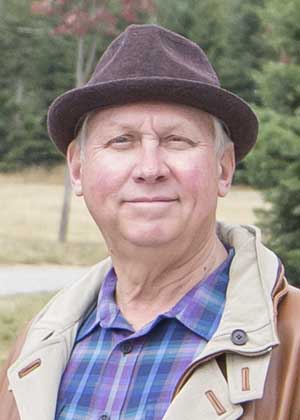
Dennis Pence
He never intended for the place to make money.
“The way I did it was actually just out of curiosity, so the way the orchard was planted it had no possibility of having a commercial viability,” he said.
He also built a conference and retreat center as a base of operations for five different nonprofit groups he had established. Meanwhile, Pence and the university teamed up gradually, hosting interns, partnering for local programs on topics such as pollinator health, and becoming a venue for the university’s Bonner County Extension programs.
Parrella, an entomologist, began talking with Pence about transferring ownership when Parrella became dean in 2016. Parrella had just restructured a number of departments within the College of Agricultural and Life Sciences and brought many professors in soils, water, plant and entomology to feel out the place. They liked it, so the ag college decided to invest $2 million for the property valued at about $8 million. Pence donated the rest.
Pence could have afforded to give the whole thing away, he said, but wanted the university to have some skin in the game. “I knew that if they had to pay money — because we’re all alike — then that would create a sense of responsibility by all the stakeholders in the university, and I think it has,” he said.
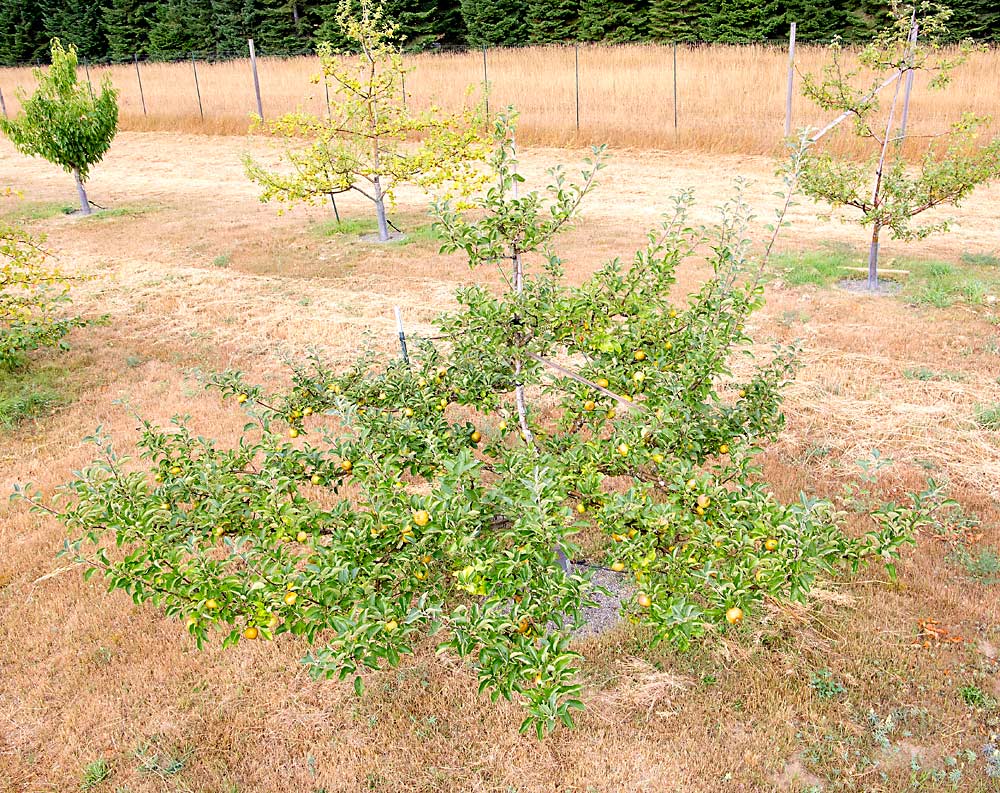
A spreading Roxbury Russet apple tree, which grows more like a bush, has a canopy of about 16 feet but stands only about 7 feet tall. (Ross Courtney/Good Fruit Grower)
Life on the farm
While the university began ramping up the academic aspects of the center last fall, Nagy and his crew continued to chip away at the annual orchard chores. Jana Hershberger, his assistant orchard manager, and seasonal employee Josie Greenwood climbed ladders to harvest the Snow and Nonsuch (sometimes referred to as Nonesuch) varieties, while Nagy continued to track the seed development and flavor from neighboring trees for maturity.
“What are you thinking about the Mother, Jana?” Nagy asked, as they all bit into samples of the sweet apple variety. “I’m kind of thinking to let it wait.”
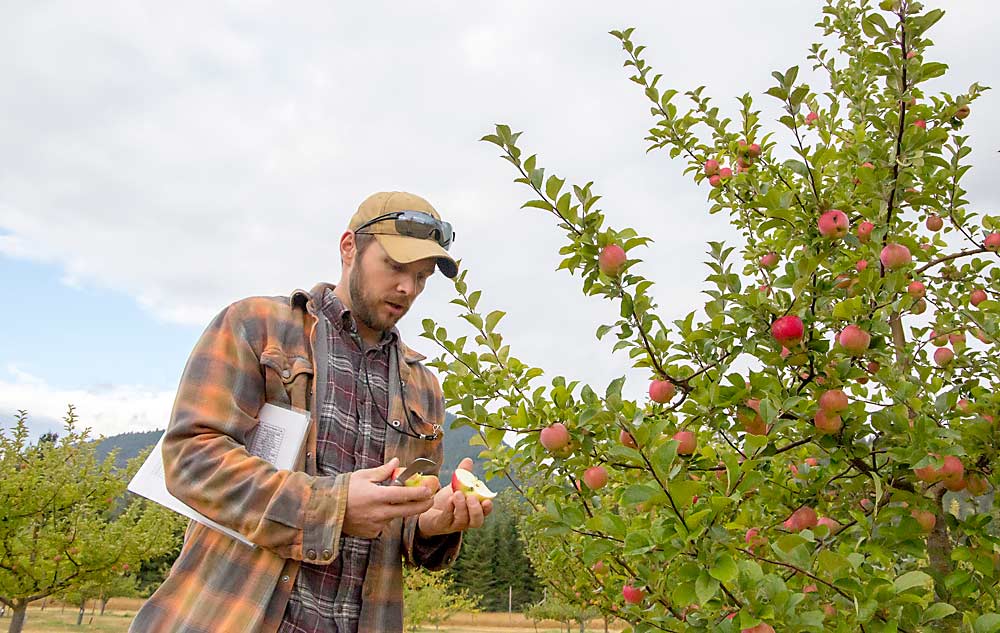
Nagy checks out the inside of a Gravenstein, using seed development and flavor to determine ripeness. (Ross Courtney/Good Fruit Grower)
Hershberger agreed: “I think so. I think it could get a better flavor.”
The varietal diversity allows Nagy and Hershberger to manage the orchard themselves with the help of a few seasonal workers, interns and graduate students who stop by periodically to help. It also ensures ample pollination season overlap, he said. The most labor-intensive part of the orchard is summer thinning, Nagy said, and despite the damp climate of Northern Idaho, the orchard has had little trouble with blight so far.
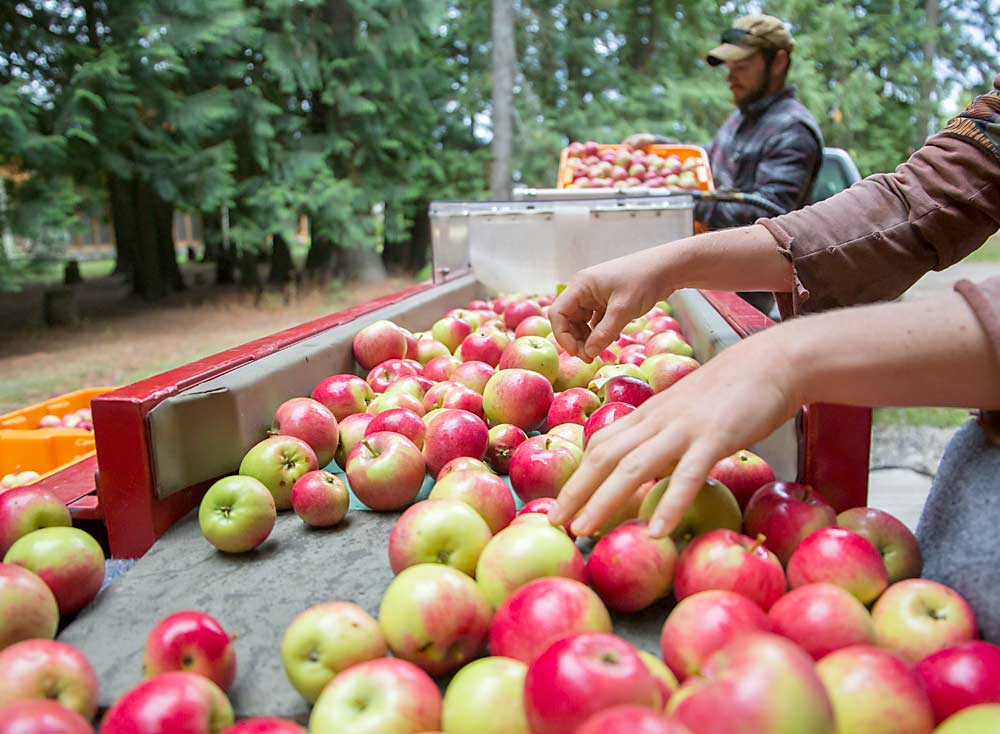
Ffreshly picked Snow apples make their way down a cleaner before being stored for cider and fresh sales. The center is known in local markets for its organic cider. (Ross Courtney/Good Fruit Grower)
Of course, fall involves harvest, one tree at a time. Nagy and his team wash the apples outside a cold-storage room that doubles as a dorm. Many of the apples are sold fresh at two Sandpoint grocery stores, while the orchard’s cider — pressed with a blend of 30-plus varieties — has its own local following.
The cold-storage bins bear sticky note labels of Strawberry Parfait, Alexander, Ramsdell Sweet and Pink Sparkle, to name just a few of the lesser-known varieties.
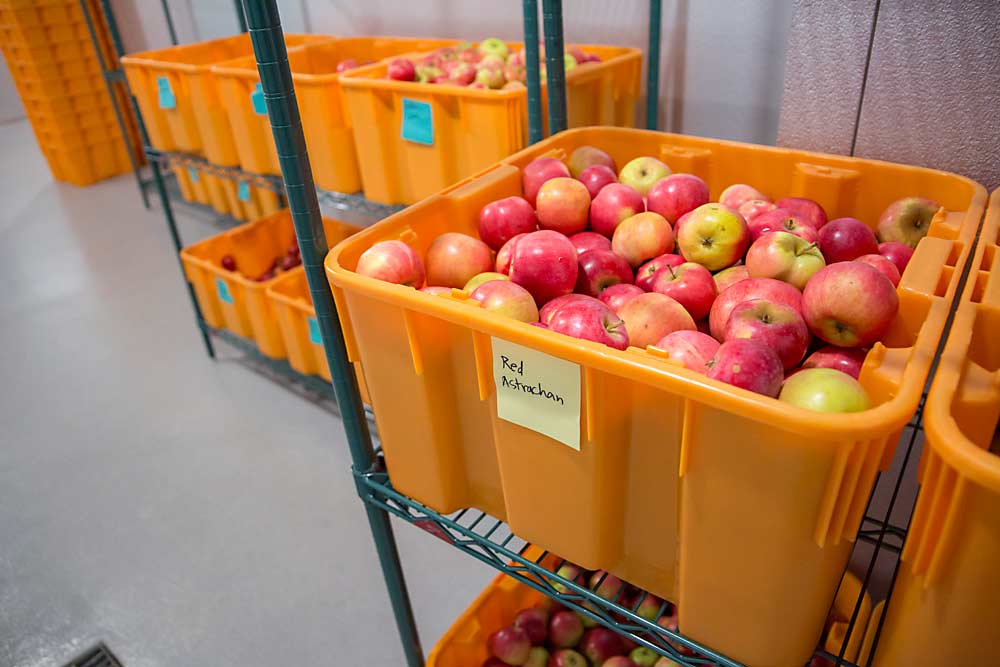
Apples await bagging or cider pressing in a cold-storage room in September 2018 at the University of Idaho Sandpoint Organic Agriculture Center. (Ross Courtney/Good Fruit Grower)
Nagy’s favorite, though, is the Seek-No-Further, supposedly named by growers back East who planted the trees near the road so passersby would help themselves but not go any further onto their private property. The apple’s light green skin bears a hint of blush when ripe and stands out when the fall light hits it just right.
“It’s like it’s lit up like a Christmas tree,” Nagy said. “It’s like it glows when you see it.” •

The morning sun hits green Seek-No-Further apples, drying raindrops left the previous evening. (Ross Courtney/Good Fruit Grower)
—by Ross Courtney






Leave A Comment